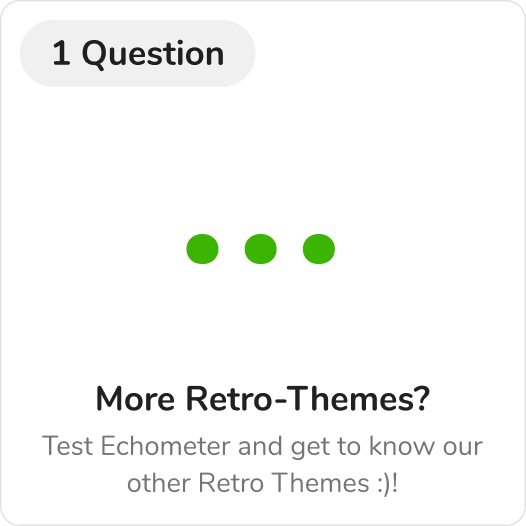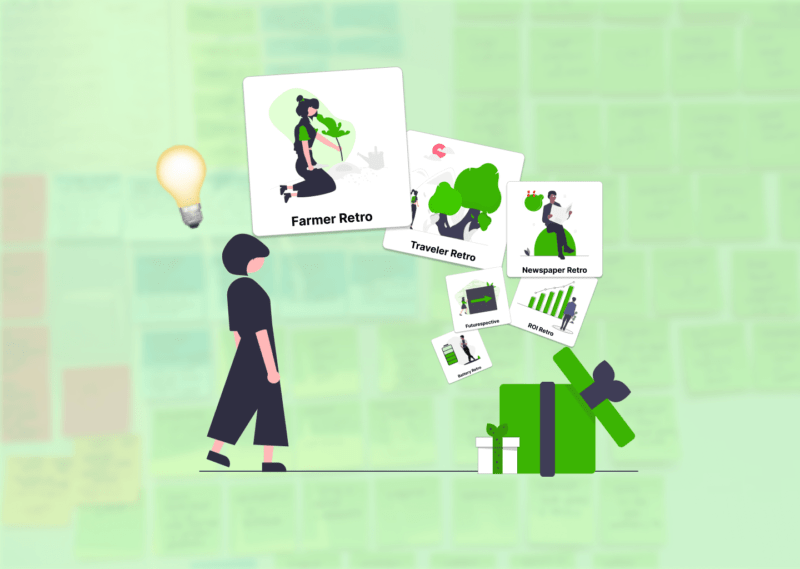Experience report - the format
How is Echometer actually used in practice? And by whom? We want to answer these questions in a number of Echometer testimonials . In this series, we will interview some of our users.
Our series continues with Dörte Ulrich's experience report. Dörte is a Scrum Master at Mobiliar.
Mobiliar is an insurance company founded in Bern in 1826. As a future-oriented company, it is dedicated to various innovative ideas and faces the new challenges of the digital future.
Introduction of Dörte and her experiences with agile work
Echometer: To start things off, would you like to briefly introduce yourself?
Dörte: I'm Dörte Ulrich and I've been a scrum master at Mobiliar - 3 years since the agile transformation took place. I now look after three teams and, as a scrum master, I am responsible for coaching the teams and moving them forward.
Echometer: How long have you been working agile?
Dörte: Our company has been working in an agile environment for almost 5 years. It all started with hybrid IT. At that time, there were both projects and agile ways of working. We have been working genuinely agile for 3 years – with PI Plannings, in which the entire IT department sits together and plans the next 3 months together. We have four peer plannings a year with 400 people on site, and it is of course more remote at the moment.
Mobiliar and teamwork
Echometer: So you currently work with your teams more remotely than on site?
Dörte: Yes, we are now mainly working from home. 50% are allowed to work on site according to the current social distancing regulations – of course not everyone can be there. But in IT we can also work really well online. It was no problem for us to adapt to this situation.
Use of Echometer at Mobiliar

Echometer: How long have you been using Echometer in your teams?
Dörte: Christian wrote to me about 1.5 years ago on LinkedIn and said that he had a cool tool that we could try out. So I suggested using Echometer to my teams, and we started piloting it.
Before the Echometer, I always ran retros with a whiteboard. Everyone stuck their own post-its on with listed problems and comments. Somehow that didn't work out that well, because not everyone was willing to make negative aspects of their work known to others.
"Using Echometer, we have the advantage that the answers can be submitted anonymously and that people have dared to express more negative things."
Dörte Ulrich
Expectations of Echometer
Echometer: What did you hope to achieve from using Echometer?
Dörte: I hoped that there would be more dynamism in the retros, and that problems would be recognized more easily. I also wished that Echometer would make it easier to understand the idea of retros itself.
Before, I already collected the post-its beforehand and then entered them together as votes on an idea board so that nothing is forgotten, but it is not as present as with Echometer. You are brought through the steps and can determine your action items at the end, which makes it much more easy to understand.

In addition to this, the results are quickly visible to everyone – that was unfortunately not the case with OneNote, the tool we used before. With the idea boards, everyone has to think about what the notes mean and what the comments were.
Using Echometer there is also the advantage that you do the survey before the actual retro. – I usually send it a week in advance. This gives employees more time to think about the questions. In the case of a retro with post-its stuck on a wall, most of the people only think about the aspects of the retro when they are actually there. This way, everyone has more time to reflect.
Supporting teamwork with Echometer
Echometer: How was team's feedback on Echometer?
Dörte: The feedback from the team was very good from the start! They were all excited. They really like the scale rating, in which I and the team can see how motivated everyone is, what the mood and the level of success are.
"The feedback from the team was very good from the start!"
Dörte Ulrich
Echometer: That's our pleasure! Can you perhaps describe in more detail how you use Echometer with your teams?
Dörte: We do a retro every four weeks. One week before the retro, I'll send out a survey with selected items and questions. For these, all team members can give a rating. Some of these also relate to our internal company goals, which were entered for us in the software as organizational items, and which we can now also track with the aid of the scaled ratings from staff.
Then the real retro starts. At check-in, I think it's good that there are different alternatives to loosen up the retro atmosphere. Then we look at the results of the survey together and can also look at the evaluations over time. This usually results in small discussions about the changes – where we talk about why things might be different this time.
When discussing the open questions, we try to determine the actual problem directly and think about whether there are any action items we can create. Then we look at the existing action items, checking which measures have been implemented or which we need to add.

At the end, there is a short check-out and the retro is over.
Echometer: How big are your teams?
Dörte: I started with a team of 12 people. Now, the team has been divided into two teams, each with 5-6 people.
Favorite features of Echometer
Echometer: Do you have a favorite feature of Echometer?
Dörte: I think the action items are good and I like that you can track and record them well using Echometer.
Echometer: You said that you like to use the theme with positive and negative questions. Is “Good & Bad” your favorite retro theme on Echometer?
Dörte: Yes, this is the team favorite.



Echometer: Which items do you use in your retros?
Dörte: We use both the items available for selection from Echometer, and the organization-wide echo items that are tailored to our central goals. Since we have five or six sub-goals, it is good that the topics always rotate, so you get each one coming back in the cycle.
I also like the items from Echometer. There are many that fit well to our work. The results can then be shown at a glance to the other admins and managers, who are supposed to track the development of the teams, and briefly discuss them without feeling forced. We used to organize all this with OneNote, but it didn't work out so well.
"The team development is really easy to follow and is displayed clearly - that's why I am so enthusiastic about Echometer!"
Dörte Ulrich
Dörte's tip for using Echometer
Echometer: What advice can you give to other companies who want to use Echometer?
Dörte: Just give it a try, because it really is a very good tool-based solution. You can generate significantly more discussions with Echometer than with conventional methods.
Our interview partner

Dörte Ulrich
Scrum Master at Mobiliar
"You can generate significantly more discussions with Echometer than with conventional methods."
Dörte Ulrich
Conclusion – Echometer in a nutshell
Echometer: What is your final conclusion on Echometer?
Dörte: My personal conclusion is that it's simply a good tool. Especially now during the Coronavirus, it's great because you can also do the retros online. It really encourages discussion and willingness to deal with certain things.
The discussions remain structured and don't get out of hand. With Echometer, the retros follow a common thread. In this way, it is possible to steer the discussions better and lead them back to the core if you digress a little. Because of this, I also no longer felt the dissatisfaction can arise when team members were of the opinion that something was not being discussed properly.
“Because the facts and action items are clearly displayed, everyone has a more positive feeling - they notice that the retro really does something. It was not like this before."
Dörte Ulrich
Echometer: Thank you for taking the time to tell us about your experiences with Echometer!
Did that sound exciting to you? Would you like to know more about Echometer?
Take the opportunity and learn about how Echometer works with a free online demo with Christian!
If you are already on board with us and would like to share your experiences as well, please contact Jean!











